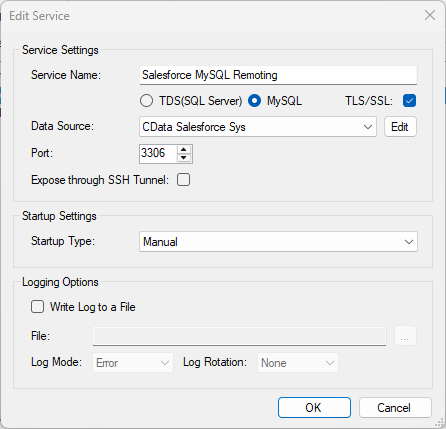Discover how a bimodal integration strategy can address the major data management challenges facing your organization today.
Get the Report →How to Query Sybase Data in MySQL Workbench
Execute MySQL queries against live Sybase data from MySQL Workbench.
You can use the SQL Gateway from the ODBC Driver for Sybase to query Sybase data through a MySQL interface. Follow the procedure below to start the MySQL remoting service of the SQL Gateway and work with live Sybase data in MySQL Workbench.
Connect to Sybase Data
If you have not already done so, provide values for the required connection properties in the data source name (DSN). You can use the built-in Microsoft ODBC Data Source Administrator to configure the DSN. This is also the last step of the driver installation. See the "Getting Started" chapter in the help documentation for a guide to using the Microsoft ODBC Data Source Administrator to create and configure a DSN.
To connect to Sybase, specify the following connection properties:
- Server: Set this to the name or network address of the Sybase database instance.
- Database: Set this to the name of the Sybase database running on the specified Server.
Optionally, you can also secure your connections with TLS/SSL by setting UseSSL to true.
Sybase supports several methods for authentication including Password and Kerberos.
Connect Using Password Authentication
Set the AuthScheme to Password and set the following connection properties to use Sybase authentication.
- User: Set this to the username of the authenticating Sybase user.
- Password: Set this to the username of the authenticating Sybase user.
Connect using LDAP Authentication
To connect with LDAP authentication, you will need to configure Sybase server-side to use the LDAP authentication mechanism.
After configuring Sybase for LDAP, you can connect using the same credentials as Password authentication.
Connect Using Kerberos Authentication
To leverage Kerberos authentication, begin by enabling it setting AuthScheme to Kerberos. See the Using Kerberos section in the Help documentation for more information on using Kerberos authentication.
You can find an example connection string below:
Server=MyServer;Port=MyPort;User=SampleUser;Password=SamplePassword;Database=MyDB;Kerberos=true;KerberosKDC=MyKDC;KerberosRealm=MYREALM.COM;KerberosSPN=server-name
Configure the SQL Gateway
See the SQL Gateway Overview to set up connectivity to Sybase data as a virtual MySQL database. You will configure a MySQL remoting service that listens for MySQL requests from clients. The service can be configured in the SQL Gateway UI.

Query Sybase from MySQL Workbench
The steps below outline connecting to the virtual Sybase database created in the SQL Gateway from MySQL Workbench and issuing basic queries to work with live Sybase data.
Connect to Sybase through the SQL Gateway
- In MySQL Workbench, click to add a new MySQL connection.
- Name the connection (CData SQL Gateway for Sybase).
- Set the Hostname, Port, and Username parameters to connect to the SQL Gateway.
- Click Store in Vault to set and store the password.
- Click Test Connection to ensure the connection is configured properly and click OK.

Query Sybase Data
- Open the connection you just created (CData SQL Gateway for Sybase).
- Click File -> New Query Tab.
- Write a SQL query to retrieve Sybase data, like SELECT * FROM `CData Sybase Sys`.Products;

With access to live Sybase data from MySQL Workbench, you can easily query and update Sybase, just like you would a MySQL database. Get started now with a free, 30-day trial of the CData ODBC Driver for Sybase and the CData SQL Gateway.






